
The Australian state of South Australia issued revenue stamps from 1894 to 2003. There were various types for different taxes. [1]

The Australian state of South Australia issued revenue stamps from 1894 to 2003. There were various types for different taxes. [1]
South Australia's first Bailiff Fee stamps were issued in 1982 and the designs were similar to earlier stamp duty revenues but with new inscriptions. Stamps in the same design but with differences in perforation or colour were issued until 1990, and they were used until about 2002.
The first beer duty stamps were issued for beer in kegs in 1894, and like issues for the other Australian states, most were damaged or destroyed in use so most existing examples are in mint condition. The second issue was in 1903, and stamps in similar designs for use on kegs or bottles were issued until 1918. Later that year they were replaced by Australian Commonwealth beer duty issues.
These were used for compensation in case of slaughter for reasons of infection, and the first set was issued in 1940. A second set was issued in 1966 in decimal currency and these remained in use until 1994.
South Australia's first Court Fee stamps were issued in 1982 and the designs were similar to earlier stamp duty revenues but with new inscriptions. Stamps in the same design but with differences in perforation or colour were issued until 1990, and they were used until about 2002.
The first design was issued in 1936 and the set consisted of nine values ranging from 1s to £1. This was overprinted STAMP a year later to comply with the exact wording of the law, and a new set with corrected inscriptions was issued later.
These were used as receipts by the South Australia Harbours Board for wharfage fees on fish landed. The first issue was a numeral design and reprints continued until 1931 with changes in perforation. They were used until 1954.
The first stamp duty revenues were issued in 1902 with the portrait of King Edward VII and they replaced fiscally used postage stamps. This design continued to be used until it was replaced by a numeral type in 1916. This design remained in use and a set in decimal currency was issued between 1966 and 1976. In 1977 a new set with the symbol of the state, a magpie, was issued, and stamps in this and a similar design were issued until 2003.
These were used for compensation in case pigs had to be destroyed for reasons of infection, and the first set was issued in 1937. A second set was issued in 1966 in decimal currency and reprints of this set continued to be issued until around 1985.
Only one set of tax instalment stamps was issued, in 1941. It was the keytype used in all Australian states, overprinted S.A. below the value. Twenty nine values ranging from 1d to £5 were issued, and are most commonly found in mint condition.

This is an overview of the postage stamps and postal history of Australia.

The postal history of the Bahamas begins in the 18th century, with the first post office operating since 1733. The earliest known letters date from 1802. In 1804 a straight-line "BAHAMAS" handstamp came into use. The Royal Mail Line initiated a regular mail service in 1841, and from 1846 used a "Crown Paid" handstamp along with a dated postmark for New Providence.

Revenue stamps of Malta were first issued in 1899, when the islands were a British colony. From that year to 1912, all revenue issues were postage stamps overprinted accordingly, that was either done locally or by De La Rue in London. Postage stamps also became valid for fiscal use in 1913, so no new revenues were issued until 1926–30, when a series of key type stamps depicting King George V were issued. These exist unappropriated for use as general-duty revenues, or with additional inscriptions indicating a specific use; Applications, Contracts, Registers or Stocks & Shares. The only other revenues after this series were £1 stamps depicting George VI and Elizabeth II. Postage stamps remained valid for fiscal use until at least the 1980s.

Revenue stamps of the United Kingdom refer to the various revenue or fiscal stamps, whether adhesive, directly embossed or otherwise, which were issued by and used in the Kingdom of England, the Kingdom of Great Britain, the United Kingdom of Great Britain and Ireland and the United Kingdom of Great Britain and Northern Ireland, from the late 17th century to the present day.
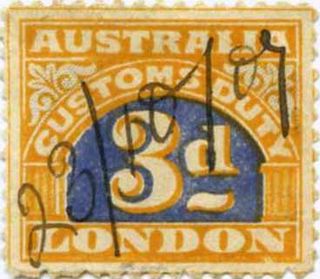
Australia issued revenue stamps from 1907 to 1994. There were various types for different taxes. In addition to Commonwealth issues, the states of New South Wales, Queensland, South Australia, Tasmania, Victoria and Western Australia as well as the territories Australian Capital Territory, North Australia and Northern Territory also had their own stamps.

South Africa issued revenue stamps from 1910 to 2009. Apart from national issues various provinces of the country issued revenues from around 1855 to c. 1970.
The Australian state of Western Australia issued revenue stamps from 1881 to 1973. There were various types for different taxes.

The Australian state of Victoria issued revenue stamps from 1870 to around 2000. There were various types for different taxes.
The Australian state of Tasmania issued adhesive revenue stamps from 1863 to 1998, although impressed stamps had appeared briefly in the 1820s. There were general revenue and stamp duty issues, as well as a number of specific issues for various taxes.

The Australian state of Queensland issued revenue stamps from 1866 to 1988. There were various types for different taxes.
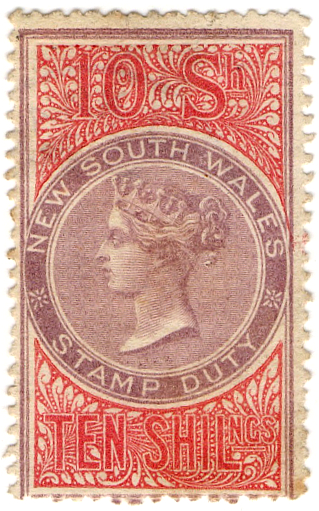
The Australian state of New South Wales issued revenue stamps from 1865 to 1998. There were various types for different taxes.

Trinidad and Tobago, formerly divided as two separate colonies, issued revenue stamps from 1879 to around 1991.

Eritrea first issued revenue stamps under the Italian Eritrea administration. It continued to issue revenues under British and Ethiopian occupation, as well as when it became an independent state. The capital Asmara also issued some revenues.
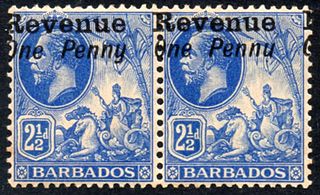
The island of Barbados first issued revenue stamps in 1916. There were various types of fiscal stamps for different taxes.

The South African Republic (ZAR), later known as Transvaal issued revenue stamps from 1875 to around 1950. There were a number of different stamps for several taxes.
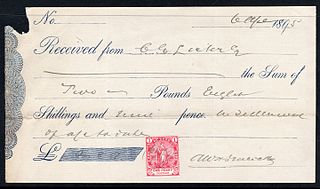
Cape of Good Hope issued revenue stamps from 1864 to 1961. There were a number of different stamps for several taxes.

New Zealand first issued revenue stamps on 1 January 1867 and their general use continued until the early 1950s. The only Revenue Stamp series still in use today is the Game Bird Habitat stamp which is used for payment of the Gun License for the duck shooting season which begins the first weekend of May. There were various types of fiscal stamps for different taxes.
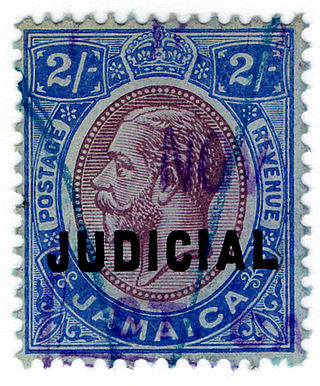
Revenue stamps of Jamaica were first issued in 1855. There were various types of fiscal stamps for different taxes.

Hong Kong issued revenue stamps from 1867 to the 1990s, both when it was a British colony as well as when it was under Japanese occupation.
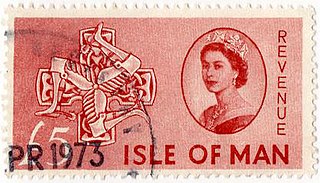
Revenue stamps of the Isle of Man refer to the adhesive revenue or fiscal stamps which were issued by the British Crown dependency of the Isle of Man between 1889 and 1976. British key type revenue stamps with an appropriate inscription were issued on the island until 1966, when revenue stamps showing various scenes and symbols of the island began to be issued. The last set of stamps was issued in 1976. From around 1920 to the 1970s, hundreds of contribution stamps were issued for National Insurance and related schemes.